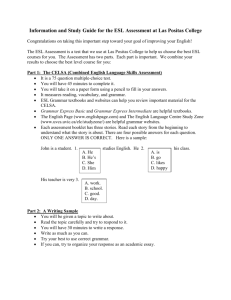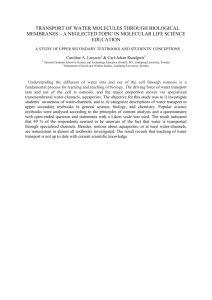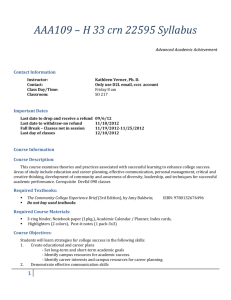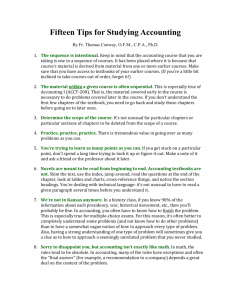Cultural Bias in ESL Textbooks
advertisement
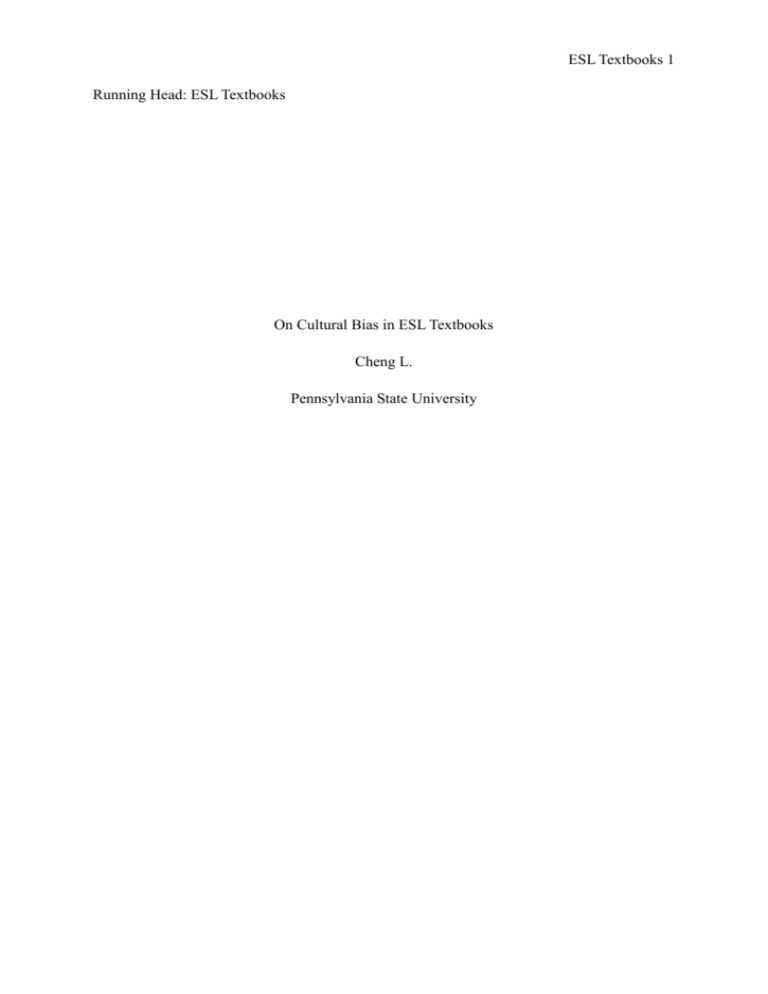
ESL Textbooks 1 Running Head: ESL Textbooks On Cultural Bias in ESL Textbooks Cheng L. Pennsylvania State University ESL Textbooks 2 Instructional materials expressively influence students’ mastery of knowledge and their values about themselves and people around them (Hirschfelder, 1982). This is particularly evident in students of English as a Second Language (ESL) who use ESL textbooks not only as a trusted resources for the skills necessary to master the new language, but also as an effective tool to negotiate the new culture. As instructional materials transmit social values as cultural mediators, they exert their effects positively or negatively on students’ perceptions of culture (Ndura, 2004). It has been found that some instructional materials contain bias, for instance, by under-representing minority societies (Hirschfelder, 1982; Ndura, 2004) which hampers students’ learning. In the present paper, the role of cultural bias in ESL textbooks plays in students’ learning is investigated. It is hypothesized that the ESL textbooks which are not culturally diverse will bring negative effects on students to learn English. The following four literature reviews attempt to demonstrate and support the hypothesis. In a research article by Ndura (2004), the author presented his findings from an analysis of selected ESL textbooks for cultural bias, discussed the potential influence of these biases on students’ acculturation process, and summarized some effective strategies to confront these biases. The selection of ESL textbooks consisted of six different ones used in a school district in the Western USA, and represented the kind of the commonly used ESL textbooks in US schools. The author did lots of research on background information of these textbooks, which concerned about the philosophical framework, themes, supplementary workbooks, and activities in both students’ and teachers’ editions. The finding was that three major forms of cultural bias were concluded by the author, which were stereotyping, invisibility, and unreality. Stereotyping refers to the portrait of one set of people exhibiting one set of values, ESL Textbooks 3 behaviors and roles, for instance, among 29 people pictured using various tools in one ESL textbooks, 18 are male and only 11 are female. It was also found that males were involved in more complex activities. Invisibility is the omission of information about any of the main variables that help form our cultural identity individually and collectively (Ndura, 2004). For example, the author found that none of the six textbooks mentioned any kind of religious building, which he thought was an ignorance of the significant role that religion played in human culture. Furthermore, invisibility results in unreality, which is a technique in which an idealistic view of national history and current issues is valued, with the avoidance of discrimination and prejudice consciously. The author discussed that the failure of addressing the difficulties in daily life due to discrimination, racism, and poverty, denied the students the chance to learn the discourse of survival in order to deal with the harsh realities (Grady, 1997). From these findings the author indicated that ESL textbooks with cultural bias would bring negative effect to students on their worldviews, religious beliefs, and would reduce their ability to confront and overcome difficulties in real life. One limitation to this study is the analysis was made from the author’s own perspective, which may be influenced by the author’s personal bias, such as his cultural, academic and professional background. Another limitation is about whether or not the selected ESL textbooks are representative, or they were viewed representative just from the author’s own experience. Since they were all textbooks used in the Western USA, it excluded the possibility that ESL textbooks in other areas were greatly different with those in Western, which meant they were free of cultural bias. Next, in the research article by Joel (2009), two specific questions were addressed for guiding the study. First, what influences would cultural bias in the teaching of English and in ESL Textbooks 4 the books used to teach English in primary schools attended by Khoe students in eastern Botswana bring? Second, would cultural bias correlate with the attitudes and motivation of Khoe students learning English. It is hypothesized that cultural bias in instructional materials will hamper learning and affect the way one perceive oneself and others (Joel, 2009). The sample consisted of one hundred and thirty-seven students, who completed an attitude and motivation questionnaire adapted from Gardner’s (1985) Attitude and Motivation Test Battery. Besides, interviews were made on five of the students and twelve teachers to obtain their opinions on cultural bias in English textbooks. In addition, based on the investigation of Ndura (2004) of ESL textbooks for invisibility, unreliability and stereotyping of learners’ cultures, an analysis of English language textbooks for Standards 4 –7 for culture bias was made. The results in this study contradicted the hypothesis that cultural bias in ESL textbooks would influence learners’ attitude and motivation negatively. It showed that although ESL textbooks were not diverse in culture and the English learners didn’t understand the culture of English countries, this didn’t have any effect on the attitude and motivation of the students learning English, that they were still highly motivated to learn English. The results also indicated the reason of the phenomenon above may be that the students and teachers had little knowledge and awareness of cultural bias’ relationship with ESL learning. One of the implication of the findings of this study is that in order to include the lives and experiences from different cultural background, the English teaching and ESL textbooks in schools should be in cultural diversity, and teachers should be inculcated awareness of cultural diversity, and trained to adapt their teaching to specific cultural situations (Joel,2009).One limitation to this study is whether or not the method of information collection like the attitude and motivation ESL Textbooks 5 questionnaire for students and the interviews on students and teachers are as precise as a dimensional measure might be. With this method the extent to which the students and teachers display their motivation can be measured. Since the information is from the students and teachers themselves, it is highly possible that their subjective ideas might conceal their true feelings to the researcher, which makes the research unreliable. Another limitation to the study is the fact that all the individuals involved were from the same socio-economic status, and the same culture background, that they exclude other cultures. We cannot deny the possibility that Khoe’s culture may have its specific trait such as supporting the spirit of obedience, so the omission of their cultures in ESL textbooks would bring little influence to students’ learning. However, when the same situation comes to students from other cultures, the results might be totally different. Furthermore, the topic of cultural bias in relation to ESL textbook is addressed according to the ways to evaluate ESL textbooks. In a research article by Sokolik (2007), the author investigated the traditional method of using checklist to evaluate ESL textbooks, especially grammar textbooks. By researching on different checklists, the author found that the focus of them were on the use of structures, types of exercise, illustrations, and instructor guidance, without any mention of evaluation of racism, sexism, economic bias, or other stereotypes. The sample the author used were all from ESL grammar books or ESL grammar websites, and he particularly pointed out that those examples didn’t represent a preponderance of the kind of sample sentences in any one textbook, however they were not isolated cases that each of the textbooks he cited consisted of multiple example sentences like those he had showed (Sokolik, 2007). The results indicate that although there is growing awareness of cultural bias ESL Textbooks 6 especially gender and racial bias in publishing, there is still little mention of socio-economic bias. As the author found, the participants in the example sentences in these ESL textbooks all seem to have a kind of lifestyle for leisure purpose, such as take vacations, play golf, and buy new cars and house, which is a reflection of privileging of upper-middle class and omission of lower socio-economic classes. One of the reasons of these problems in ESL grammar textbooks is that these books are often viewed just as a carrier to illustrate a particular sentence structure, with little attention paid to the content of these sentences. At the end, the author concluded that although the socio-economic bias in textbooks has been generally noted in discussion of various textbooks, but not in reference to ESL textbooks, or grammar books specifically, at least to his knowledge (Sokolik, 2007). Therefore, he suggested that in the process of evaluating grammar textbooks, we must not only pay attention to the table of contents or the instructor’s manual, but also focus on the values being taught from the sample sentences. One limitation of this study concerns about the time constraint that the sample sentences seem to be the products of the times in which they were written, thus most of the sentences analyzed are from the books written before 2007, that the situation of cultural bias reflected in grammar textbooks today might change a lot. Another limitation is also about the sample sentences collected by the author. For example, no information was given about students of which ages these grammar textbooks are used for, or in which country or area these textbooks are published. Without this information, we are not sure whether these grammar textbooks are representative enough. Finally, in a research article by Sherman (2010), the author guided his study by addressing a question of what forms of cultural bias and gender bias are TESOL course books ESL Textbooks 7 presenting to non-native students in the model dialogues? And three specific questions were addressed. First, how are non-native female and male speakers represented correlating to native female and male speakers? Second, how are non-native female speakers represented in relation to non-native male speakers? Third, is there any relationship between the ways in which native female speakers are represented and the ways in which native male speakers are presented? The focus of this investigation was on an analysis of four current TESOL course books to look for speaker bias, by adapting parts of two frameworks previously used in analyzing gender bias in textbooks. The first framework is Jones, Kitetu and Sunderland’s (1997) ideas of initiation, turns taken and words spoken. For initiation inequality, for example, it was found in one textbook that non-native females never began a mixed-sex or same-sex dialogue. For gender bias on words spoken, it was found in textbooks that native males spoke the fewest words while males generally spoke fewer words than females. To sum up, the results indicate that non-native speakers are portrayed in a more passive way, but they are more willing to respond to, while native speakers always initiate a dialogue. And non-native females are less likely to speak first in mixed-sex pairs conversations. Besides, the author followed Lesikin’s (2001) procedure of six detailed steps to analyze the theme, rhyme and participant roles in language used in TESOL textbooks, basing on Lesikin’s framework which considers that the language use determines the participants’ roles, rather than the social role determines the language used. The results indicate that three of the four books showed obvious imbalance in who was exhibited in a more significant position in communication. In other words, not only in positions of communicative prominence but also in participant roles, native speakers were portrayed more, which will give students an assumption that native ESL Textbooks 8 speakers have higher social status and greater social power than non-native speakers. Although non-native speakers have been introduced into TESOL textbooks, they are not exhibited in a way free of bias, and some forms of gender bias still exist in such textbooks (Sherman, 2010). Taken together, the results indicate that cultural bias in ESL textbooks plays a significant role in ESL learning. It can be assumed from these four literature reviews that cultural bias influences students not only in their study, but also in their integration into the new culture and their values towards the world. Too many mentions of money, shopping, and vacation will leave young students an impression that only the wealthy can have the best way to relax, thus conceptualize them a culture of desire, which make them pay more attention to material world. While students from lower classes will feel marginalized by others who seem to be wealthy, and be easily conceived an illusion that money values much, whereas actually there are so many other things even more valuable and worth praising, such as virtues of honesty, diligence, and frugality. More studies for Scio-economic bias and speaker status bias in ESL textbooks should be conducted, just as many studies have been done for gender bias over the years (Sherman, 2010). Furthermore, not only students could be involved in to respond their attitude towards cultural bias, but also native and non-native teachers and parents should be considered in studies in the future. ESL Textbooks 9 References Hirschfelder, A. (1982). American Indian stereotypes in the World of Children: A Reader and Bibliography. Metuchen, NJ: The Scarecrow Press. Nadura, E. (2004). ESL and cultural bias: An analysis of elementary through high school textbooks in the Western United States of America. Language, Cultural and Curriculum, 17(2), 143-153. Grady, K. (1997). Critically reading an ESL text. TESOL Journal, 7–10. Sokolik, M.E. (2007). Grammar textbooks and consumerist subtexts. TESL-EJ, 11(2), 1-8. Joel,M.M. (2009). The influence of cultural bias on motivation to learn English: the case of Khoe primary school students in eastern Botswana. Language, Culture and Curriculum, 22(1), 1-13. Gardner, R.C. (1985). Social psychology and second language learning: The role of attitudes and motivation. London: Edward Arnold. Sherman,J.E. (2010). Multiple levels of cultural bias in TESOL course books. RELC, 41(3), 267-281. Jones, M.A., Kitetu, C., & Sunderland, J. (1997). Discourse roles, gender and language textbook dialogues: who learns what from John and Sally? Gender and Education 9(4): 469-90. Lesikin, J. (2001). Determining social prominence: a methodology for uncovering gender bias in ESL textbooks. In D.R. Hall & A. Hewings (Eds) Innovation in English Language Teaching. Oxon: Routledge, 275-83.



